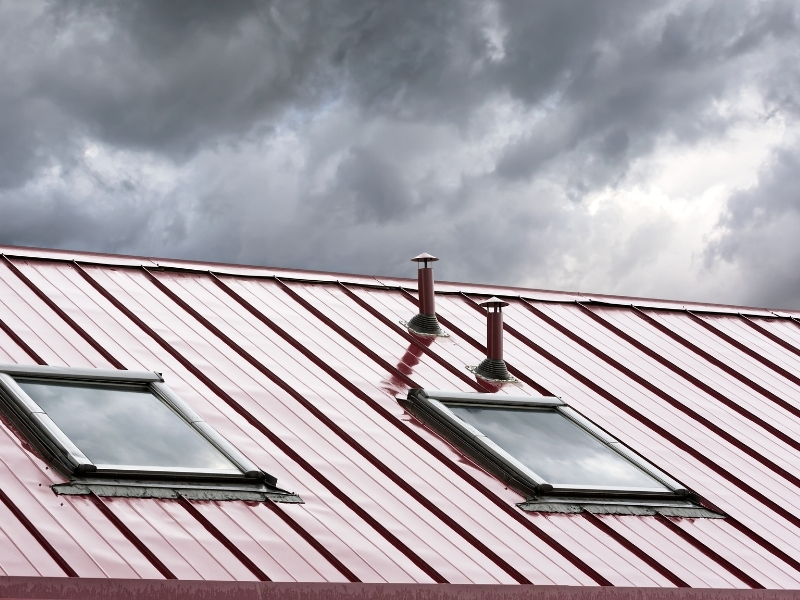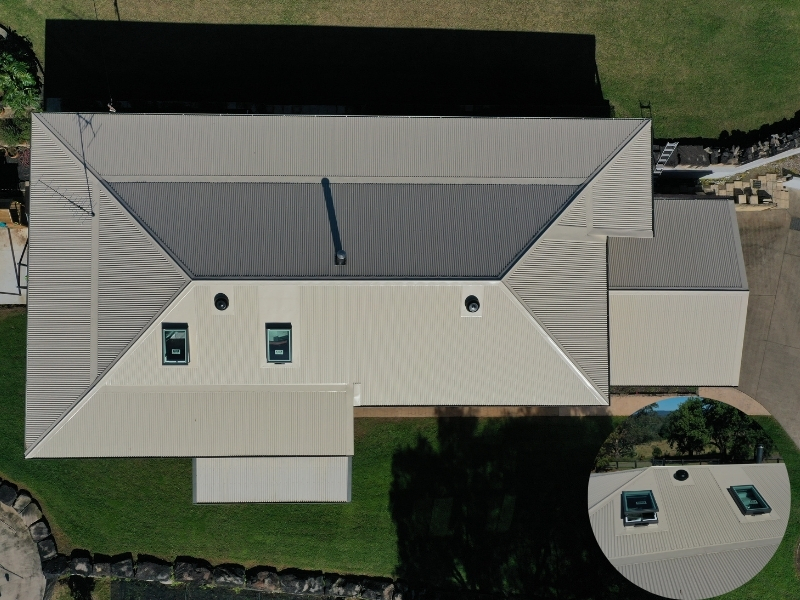Installing a skylight into your metal roof can transform your living space. Still, it’s essential to weigh the benefits against potential challenges. From energy efficiency and structural planning to ventilation and aesthetics, installing a skylight involves more than just adding a window to your ceiling. You’ll need to assess long-term performance, maintenance demands, and the interaction of light and heat with your roofing material. This article explores the key factors to consider when installing a skylight, ensuring you make an informed decision that enhances your home’s comfort and efficiency.
What are the key considerations before installing a skylight?
Installing a skylight on a metal roof isn’t as simple as cutting a hole and adding glass. Metal roofing poses unique installation challenges that require thoughtful planning and precise execution.
- Roof pitch and orientation: A roof’s slope determines the best placement and drainage for a skylight. Steeper pitches can shed water quickly, thereby reducing the risk of leaks.
- Load-bearing capacity: Verify that your roof structure can support the additional weight of the skylight, particularly during storms or with debris accumulation.
- Climate considerations: In hot or rainy climates, glazing options and flashing details become even more essential to prevent heat gain and water ingress.
- Licensing and codes: Always confirm compliance with local building codes and warranty terms to ensure proper licensing and adherence to regulations. Failing to follow them could void your roof warranty.
If you’re weighing up your options, take the time to explore reliable methods for installing a skylight on your roof that suit both your roof style and long-term goals.
Planning properly avoids structural issues down the line. It ensures your skylight becomes a long-lasting feature, not a maintenance headache.
How can installing a skylight impact your home’s energy efficiency?
Skylights have the potential to either boost or drain your home’s energy performance. Done right, they reduce reliance on artificial light and improve solar gain. Done wrong, they let in heat during summer and leak warmth in winter.
- Daylight penetration: With correct placement and glazing, you can brighten dark areas of your home and reduce the need for electric lighting during the day.
- Insulating glazing options: Double or triple-glazed skylights reduce heat transfer and help maintain internal temperatures year-round.
- Solar control films and blinds: Integrating these features allows better control over heat and light without sacrificing brightness.
- Seasonal variability: A north-facing skylight will maintain steady lighting levels, while a west-facing one may overheat in summer.
One key factor often overlooked is how skylight placement affects thermal comfort, which can play a significant role in maintaining a balanced and comfortable indoor climate.
What are the common problems with installing a skylight on metal?
While skylights offer numerous benefits, installing them on metal roofs presents a unique set of challenges that can be costly if overlooked.
- Thermal movement: Metals expand and contract with temperature changes, which can strain the skylight frame and cause fasteners to loosen.
- Flashing design: A poorly designed flashing setup can lead to water pooling and eventual leaks. This is especially risky with corrugated or ribbed panels.
- Wind noise and vibration: Incorrect sealing may amplify wind noise or create pressure imbalances that cause the skylight to rattle during storms.
- Roof lifespan compatibility: Skylights often outlast roofing sheets. If installed poorly, you may need to remove them during roof repairs.
Understanding these potential pitfalls helps you set clear expectations and communicate effectively with your installer. A professional familiar with metal roofing systems is your best bet for a trouble-free outcome.

How does installing a skylight improve light and airflow?
Skylights don’t just bring in natural light — they can also breathe life into spaces that feel stale or dim. When opened, they serve as an effective ventilation solution, drawing hot air upwards and out of the home.
- Ventilation effectiveness: Placing a skylight high on a vaulted ceiling can help ventilate built-up heat that’s hard to clear with windows alone.
- Reduced reliance on AC: On mild days, you can cool your home passively without needing to switch on air conditioning.
- Even light distribution: Tubular skylights and diffusers can evenly distribute light across a room without hot spots.
- Improved mood and productivity: Exposure to daylight boosts alertness and enhances overall well-being.
These benefits demonstrate why skylights enhance natural ventilation in living areas, thereby contributing to a more comfortable home environment.
What steps help maintain a skylight after installation?
Skylights are low-maintenance but not maintenance-free. Keeping them in good condition protects your roof, insulation, and interiors from damage.
- Inspect your roof annually for leaks: Check the flashing, seals, and surrounding roof materials for signs of wear or water staining.
- Clean skylight glass: A clean skylight allows more light to enter and prevents mould growth. Use non-abrasive cleaners and soft cloths.
- Clear surrounding debris: Remove leaves and branches that could trap water or damage the skylight during storms.
- Check for internal condensation: Internal fogging may signal insulation problems that need addressing to prevent mould.
Consistent upkeep not only prolongs the lifespan of your skylight but also enhances the benefits of skylights for improving indoor ambience.
Where should you position a skylight for maximum impact?
Skylight positioning isn’t about what looks good — it’s about what works. Get the orientation, slope, and location wrong, and you risk glare, heat issues, or underwhelming results.
- North-facing benefits: Provides soft, consistent light throughout the day without excessive solar gain.
- Avoid ceiling fans and ducts: Keep skylights clear of ceiling hardware that could interfere with airflow or light.
- Bathrooms and kitchens: These areas benefit from both light and steam ventilation, especially when windows aren’t an option.
- Balance aesthetics and function: Consider sightlines from the outside — an awkwardly placed skylight can affect curb appeal.
Proper placement isn’t guesswork — it’s strategic. Factoring in light paths, roof pitch, and daily sun exposure leads to a smarter skylight layout and better performance over time.
How does installing a skylight affect your home in the long term?
Skylights aren’t a short-term feature — their effect on your home stretches across years, from energy bills to property resale value.
- Market appeal: Homes with natural light feel more inviting to potential buyers.
- Energy savings compound: The less you rely on artificial lighting, the more you save across seasons.
- Durability of materials: High-quality glazing and flashing can last for decades when properly installed and maintained.
- Resale considerations: Buyers are increasingly seeking eco-friendly and light-filled design elements in homes.
Skylights can be a long-term asset when approached with care and planning. Think of them as a lifestyle upgrade that also enhances your home’s functionality and value.
Factor | Consideration |
Structural integrity | Ensure the roof can support the skylight |
Energy efficiency | Assess potential for heat gain or loss |
Maintenance | Plan for regular cleaning and inspections |
Placement | Choose a location for optimal light and privacy |
Final thoughts
Installing a skylight on your metal roof can be a game-changer, offering enhanced lighting, improved ventilation, and a more aesthetically appealing appearance. However, it’s essential to approach the project thoughtfully, considering factors like placement, maintenance, and potential challenges. For more detailed information and assistance, you can find out what Scott’s Metal Roofing offers for metal roofs.

